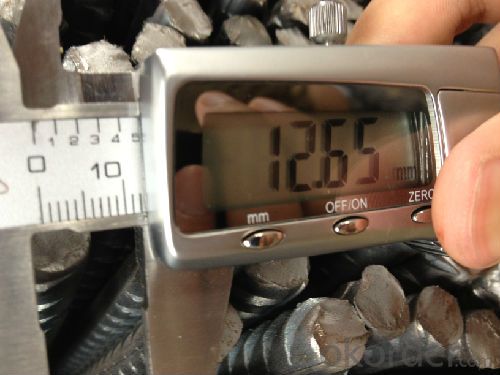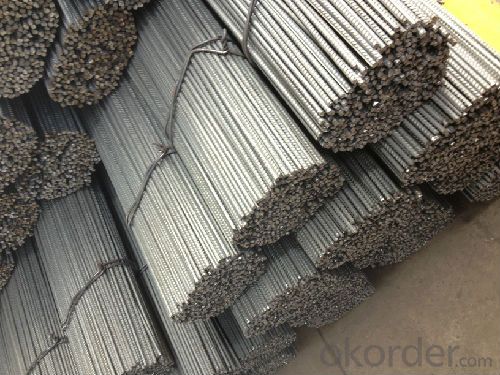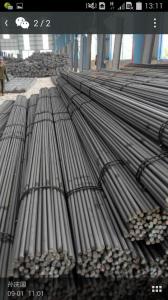Hot Rolled Deformed Bar D-BAR HRB400 HRB500 B500B B500C
- Loading Port:
- Tianjin
- Payment Terms:
- TT or LC
- Min Order Qty:
- 25 m.t.
- Supply Capability:
- 40000 m.t./month
OKorder Service Pledge
OKorder Financial Service
You Might Also Like
Product Description:
OKorder is offering Hot Rolled Deformed Bar D-BAR HRB400 HRB500 B500B B500C at great prices with worldwide shipping. Our supplier is a world-class manufacturer of steel, with our products utilized the world over. OKorder annually supplies products to European, North American and Asian markets. We provide quotations within 24 hours of receiving an inquiry and guarantee competitive prices.
Product Applications:
Hot Rolled Deformed Bar D-BAR HRB400 HRB500 B500B B500C are ideal for structural applications and are widely used in the construction of buildings and bridges, and the manufacturing, petrochemical, and transportation industries.
Product Advantages:
OKorder's Hot Rolled Deformed Bar D-BAR HRB400 HRB500 B500B B500C are durable, strong, and resist corrosion.
Main Product Features:
· Premium quality
· Prompt delivery & seaworthy packing (30 days after receiving deposit)
· Corrosion resistance
· Can be recycled and reused
· Mill test certification
· Professional Service
· Competitive pricing
Product Specifications:
Standard | GB | HRB400 | |
Diameter | 6mm,8mm,10mm,12mm,14mm,16mm,18mm,20mm, 22mm,25mm,28mm,32mm,36mm,40mm,50mm | ||
Length | 6M, 9M,12M or as required | ||
Place of origin | Hebei, China mainland | ||
Advantages | exact size, regular package, chemical and mechanical properties are stable. | ||
Type | Hot rolled deformed steel bar | ||
Brand name | DRAGON | ||
Usage and Applications of HRB400 Deformed Steel Bar:
Deformed bar is widely used in buildings, bridges, roads and other engineering construction. Big to highways, railways, bridges, culverts, tunnels, public facilities such as flood control, dam, small to housing construction, beam, column, wall and the foundation of the plate, deformed bar is an integral structure material. With the development of world economy and the vigorous development of infrastructure construction, real estate, the demand for deformed bar will be larger and larger..
Packaging & Delivery of HRB400 Deformed Steel Bar:
Packaging Detail: products are packed in bundle and then shipped by container or bulk vessel, deformed bar is usually naked strapping delivery, when storing, please pay attention to moisture proof. The performance of rust will produce adverse effect.
Each bundle weight: 2-3MT, or as required
Payment term: TT or L/C
Delivery Detail: within 45 days after received advanced payment or LC.
Label: to be specified by customer, generally, each bundle has 1-2 labels
Trade terms: FOB, CFR, CIF
FAQ:
Q1: Why buy Materials & Equipment from OKorder.com?
A1: All products offered byOKorder.com are carefully selected from China's most reliable manufacturing enterprises. Through its ISO certifications, OKorder.com adheres to the highest standards and a commitment to supply chain safety and customer satisfaction.
Q2: How do we guarantee the quality of our products?
A2: We have established an advanced quality management system which conducts strict quality tests at every step, from raw materials to the final product. At the same time, we provide extensive follow-up service assurances as required.
Q3: How soon can we receive the product after purchase?
A3: Within three days of placing an order, we will begin production. The specific shipping date is dependent upon international and government factors, but is typically 7 to 10 workdays.
Q4: What makes stainless steel stainless?
A4: Stainless steel must contain at least 10.5 % chromium. It is this element that reacts with the oxygen in the air to form a complex chrome-oxide surface layer that is invisible but strong enough to prevent further oxygen from "staining" (rusting) the surface. Higher levels of chromium and the addition of other alloying elements such as nickel and molybdenum enhance this surface layer and improve the corrosion resistance of the stainless material.
Q5: Can stainless steel rust?
A5: Stainless does not "rust" as you think of regular steel rusting with a red oxide on the surface that flakes off. If you see red rust it is probably due to some iron particles that have contaminated the surface of the stainless steel and it is these iron particles that are rusting. Look at the source of the rusting and see if you can remove it from the surface.
Images:



- Q:What is the ductility of steel rebars?
- The ductility of steel rebars refers to their ability to deform and stretch without breaking during tension or bending. Steel rebars are known for their excellent ductility, which allows them to absorb and dissipate energy when subjected to high loads or seismic forces. This property is essential in construction, as it ensures that the rebars can withstand extreme conditions and maintain structural integrity. The ductility of steel rebars also makes them suitable for various applications, such as reinforcing concrete structures and providing support in buildings, bridges, and other infrastructure projects.
- Q:Can steel rebars be used in pedestrian bridge construction?
- Yes, steel rebars can be used in pedestrian bridge construction. Steel rebars provide strength and durability to the bridge structure, making them a commonly used material for reinforcing concrete in bridge construction projects.
- Q:What is the purpose of ribbing on a steel rebar?
- The purpose of ribbing on a steel rebar is to enhance the bond strength between the rebar and the concrete. The ribs on the surface of the rebar provide a larger surface area for the concrete to adhere to, increasing the overall strength and stability of the reinforced concrete structure.
- Q:Can steel rebars be used in foundation structures?
- Steel rebars are capable of being used in foundation structures. They are frequently employed in reinforced concrete foundations to heighten the structure's strength and endurance. By bolstering the concrete's tensile strength, steel rebars effectively reinforce it. This is especially crucial in regions where the foundation may encounter substantial loads or seismic activity. To distribute the load and prevent cracking or failure, the rebars are usually positioned in a grid pattern within the concrete. In conclusion, the stability and longevity of foundation structures largely depend on the inclusion of steel rebars as an indispensable component.
- Q:What are the factors that determine the spacing of steel rebars in a concrete structure?
- The spacing of steel rebars in a concrete structure is determined by several factors that ensure the structural integrity and strength of the concrete. These factors include: 1. Structural Design: The spacing of rebars is influenced by the structural design requirements and specifications of the concrete structure. Engineers consider the loads, stresses, and forces that the structure will experience and calculate the required reinforcement spacing accordingly. 2. Concrete Strength: The strength of the concrete being used in the structure is an essential factor in determining rebar spacing. Higher-strength concrete may require closer spacing of rebars to provide adequate reinforcement and prevent cracking or failure under load. 3. Rebar Diameter: The diameter of the steel rebars also plays a role in determining the spacing. Thicker or larger diameter rebars may require wider spacing, whereas thinner rebars typically require closer spacing to provide the desired reinforcement. 4. Bar Bending and Placing: The ease of bending and placing the rebars during construction is another important factor. The spacing is often determined by practical considerations, such as ensuring proper access for workers and equipment, and facilitating the concrete pouring process. 5. Environmental Factors: Environmental conditions, such as exposure to corrosive substances or extreme weather conditions, can influence the spacing of rebars. Closer spacing may be required in corrosive environments to provide additional protection against rust and deterioration. 6. Building Codes and Regulations: Building codes and regulations set by local authorities or relevant organizations also dictate the minimum requirements for rebar spacing in concrete structures. These codes ensure compliance with safety standards and provide guidelines for construction practices. Overall, the spacing of steel rebars in a concrete structure is a critical aspect of ensuring its strength, durability, and resilience. It is determined by a combination of structural design, concrete strength, rebar diameter, construction practicalities, environmental considerations, and adherence to building codes and regulations.
- Q:How do steel rebars affect the overall sound insulation of a building?
- Steel rebars do not have a direct impact on the overall sound insulation of a building. The primary purpose of steel rebars in construction is to reinforce concrete structures and provide strength and stability. Sound insulation is primarily influenced by the materials and design of the walls, floors, and ceilings, as well as proper installation of acoustic barriers and insulation materials. While steel rebars can transmit sound to some extent due to their density, their impact on sound insulation is generally negligible compared to other factors. Sound insulation in buildings is achieved by using materials with high sound absorption properties, such as acoustic insulation panels, mineral wool, or soundproofing barriers.
- Q:Are steel rebars resistant to chemical attacks?
- The resistance of steel rebars to chemical attacks may vary depending on the specific chemicals they encounter, although they are typically resistant. Steel rebars are primarily composed of carbon steel, renowned for its exceptional strength and durability. Carbon steel exhibits good resistance to numerous common chemicals, including water, mild acids, and alkalis. Nevertheless, certain chemicals can pose a threat to steel rebars by inducing corrosion or deterioration. For instance, powerful acids like sulfuric acid or hydrochloric acid can swiftly corrode steel rebars. Furthermore, exposure to chlorides, such as those present in saltwater or deicing salts, can heighten the risk of corrosion in steel rebars. To bolster the resistance of steel rebars against chemical attacks, several protective measures can be implemented. One prevalent approach involves the application of protective coatings, such as epoxy or zinc, onto the rebars. These coatings create a barrier between the steel and the chemicals, preventing direct contact and reducing the likelihood of corrosion. In conclusion, although steel rebars generally exhibit resistance to chemical attacks, their resistance can be influenced by the specific chemicals they encounter. By implementing appropriate protective measures, their resistance can be enhanced, thus prolonging their lifespan in environments where chemical exposure is a concern.
- Q:How do steel rebars affect the overall crack control of concrete?
- Steel rebars play a crucial role in controlling cracks in concrete structures. The incorporation of steel rebars in concrete significantly enhances its tensile strength, which is otherwise quite low. When concrete undergoes tensile forces, such as those caused by drying shrinkage, temperature changes, or applied loads, it tends to crack. However, the presence of steel rebars helps to mitigate and control these cracks. Rebars act as reinforcement, providing additional strength to the concrete. They resist the tensile forces, preventing the concrete from easily cracking. When tensile forces are applied to the reinforced concrete, the rebars carry a significant portion of the load, reducing the stress on the concrete and minimizing crack formation. Moreover, the bond between the steel rebars and the concrete is integral in crack control. The bond ensures that the rebars effectively transfer the tensile forces to the concrete, enhancing its overall crack resistance. This bond also helps in distributing the applied loads evenly and reducing the risk of localized cracking. Furthermore, steel rebars can also be used to control crack widths in concrete. By specifying the appropriate diameter, spacing, and arrangement of the rebars, engineers can influence the crack widths to meet design requirements. The rebars act as barriers, limiting the width of cracks that may occur, thus maintaining the structural integrity of the concrete. In summary, steel rebars have a positive impact on the overall crack control of concrete. They enhance the tensile strength of concrete, resist tensile forces, distribute applied loads, and limit crack widths. By incorporating steel rebars in concrete, engineers can ensure the durability and longevity of concrete structures by effectively controlling crack formation and minimizing their negative consequences.
- Q:What are the different types of steel rebars available for different applications?
- There are several different types of steel rebars available for various applications. Some of the most commonly used types include: 1. Mild Steel Rebars: These are the most common type of rebars used in construction projects. They have a low carbon content and are relatively inexpensive. Mild steel rebars are suitable for general construction purposes and are used in residential buildings, bridges, and small to medium-sized structures. 2. High-strength Reinforcement Bars (HSRB): These rebars have a higher tensile strength compared to mild steel rebars. They are commonly used in high-rise buildings, large infrastructure projects, and heavy-duty structures where greater strength is required. HSRB rebars are often made from alloys such as carbon, manganese, or silicon to enhance their strength. 3. Epoxy-Coated Rebars: These rebars are coated with epoxy resin to protect them from corrosion. Epoxy-coated rebars are commonly used in marine structures, parking garages, and areas with high humidity or exposure to moisture. The epoxy coating acts as a barrier, preventing the steel from coming into contact with corrosive elements, thus extending the lifespan of the rebar. 4. Stainless Steel Rebars: Unlike mild steel rebars, stainless steel rebars contain a significant amount of chromium, which provides excellent resistance to corrosion. These rebars are often utilized in highly corrosive environments such as coastal areas, chemical plants, and wastewater treatment facilities. Stainless steel rebars are also used in structures that require a high aesthetic appeal, such as architectural buildings and monuments. 5. Galvanized Rebars: Galvanized rebars are coated with zinc to protect them from corrosion. The zinc coating acts as a sacrificial layer, corroding itself before the underlying steel is affected. These rebars are commonly used in areas with moderate corrosion risks, such as concrete structures exposed to deicing salts or in coastal regions. 6. Carbon Fiber Reinforced Polymer (CFRP) Rebars: CFRP rebars are made of carbon fibers embedded in a polymer matrix. They are lightweight, corrosion-resistant, and have high tensile strength. CFRP rebars are commonly used in retrofitting existing structures, as they provide excellent strength and durability without adding significant weight. The choice of steel rebar depends on the specific application, environmental conditions, and structural requirements. It is essential to consult with structural engineers and adhere to local building codes and standards to ensure the appropriate type of rebar is selected for each project.
- Q:Are there any codes or regulations for the use of steel rebars in construction?
- Yes, there are codes and regulations in place for the use of steel rebars in construction. In many countries, including the United States, the American Concrete Institute (ACI) provides guidelines and standards for the design and construction of reinforced concrete structures. The ACI 318 Building Code Requirements for Structural Concrete includes provisions for the use of steel rebars, detailing their requirements for size, placement, and quality. Similarly, the International Building Code (IBC) is widely adopted and provides regulations for construction practices in various jurisdictions. It includes provisions and references to standards that govern the use of steel rebars in reinforced concrete structures. Additionally, there are other standards organizations, such as the British Standards Institution (BSI) in the United Kingdom, which have their own codes and regulations for the use of steel rebars in construction. These codes and regulations are essential to ensure the safety and durability of structures. They specify requirements for the size, grade, and placement of rebars, as well as guidelines for the design, detailing, and construction of reinforced concrete elements. Compliance with these codes and regulations helps to ensure that structures are built to withstand the expected loads and perform as intended.
1. Manufacturer Overview |
|
|---|---|
| Location | |
| Year Established | |
| Annual Output Value | |
| Main Markets | |
| Company Certifications | |
2. Manufacturer Certificates |
|
|---|---|
| a) Certification Name | |
| Range | |
| Reference | |
| Validity Period | |
3. Manufacturer Capability |
|
|---|---|
| a)Trade Capacity | |
| Nearest Port | |
| Export Percentage | |
| No.of Employees in Trade Department | |
| Language Spoken: | |
| b)Factory Information | |
| Factory Size: | |
| No. of Production Lines | |
| Contract Manufacturing | |
| Product Price Range | |
Send your message to us
Hot Rolled Deformed Bar D-BAR HRB400 HRB500 B500B B500C
- Loading Port:
- Tianjin
- Payment Terms:
- TT or LC
- Min Order Qty:
- 25 m.t.
- Supply Capability:
- 40000 m.t./month
OKorder Service Pledge
OKorder Financial Service
Similar products
New products
Hot products
Related keywords






























